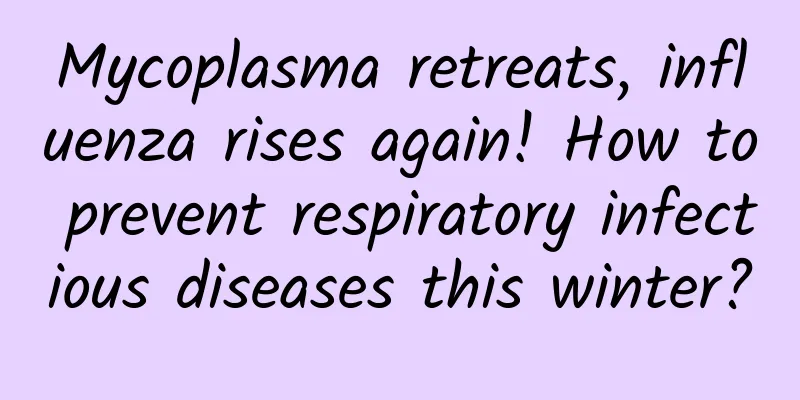Mycoplasma retreats, influenza rises again! How to prevent respiratory infectious diseases this winter?

|
Expert interviewed: Sun Zhijia, Director of General Internal Medicine and Director of Respiratory Medicine, the Third Affiliated Hospital of Guangzhou University of Chinese Medicine Recently, the outpatient and fever clinics of hospitals in many places across the country have been crowded with patients with respiratory diseases, most of whom are children. Take Beijing as an example. Some hospitals have posted notices that "emergency number waiting time is more than 24 hours"; some hospitals have thousands of emergency numbers, and even blood tests require more than 100 people to line up, and the line for medicine is circling in the hall; some hospitals' waiting areas are filled with children receiving infusions... At present, my country has entered the high incidence season of respiratory infectious diseases, showing a trend of co-epidemic of multiple respiratory infectious diseases. On November 21, Beijing Center for Disease Control and Prevention reminded citizens to take good personal protection, actively get vaccinated, and build a good immune barrier. Wang Quanyi, deputy director of Beijing Center for Disease Control and Prevention and chief epidemiologist, introduced that judging from the outpatient situation of Beijing Children's Hospital and Capital Institute of Pediatrics, the current epidemic intensity of Mycoplasma pneumoniae has dropped to fourth place, and the top three are influenza virus, adenovirus, and respiratory syncytial virus. In addition, judging from the results of respiratory pathogen monitoring, the top three reported cases of respiratory infectious diseases in the entire population of Beijing are influenza virus, rhinovirus, and respiratory syncytial virus. The reporter learned from the Beijing influenza monitoring system that the influenza virus nucleic acid positive rate of influenza-like cases in outpatient clinics has risen to 40.75%, with H3N2 being the main epidemic, accounting for 96.7%. This year's influenza epidemic period is earlier than in previous years, and the peak will also be earlier than in previous years. Similar phenomena have also occurred in other cities. From the end of October to the beginning of November, the influenza graded warning issued by the Tianjin Center for Disease Control and Prevention was upgraded from Level I (non-epidemic level) to Level II (epidemic level). Wen Daning, director of the Department of Pediatric Infection at Wuhan Jinyintan Hospital, said that the number of Mycoplasma pneumoniae infections has decreased at this stage, and influenza has gradually become popular. In October, almost all patients in the ward were infected with Mycoplasma pneumoniae. Recently, Mycoplasma pneumoniae infections and influenza each accounted for half. According to the Liaoning Provincial Health Commission, the number of influenza cases in Shenyang has been on the rise recently, with children under 14 years old accounting for the largest proportion. Etiological monitoring data show that there are many cases of respiratory infections caused by a variety of pathogens such as influenza and respiratory syncytial virus, and there are mixed infections and cross infections. Sun Zhijia, director of the Department of General Internal Medicine and the Department of Respiratory Medicine at the Third Affiliated Hospital of Guangzhou University of Chinese Medicine, said that respiratory infectious diseases usually occur in local, short-term clusters when the seasons change or the temperature drops suddenly. "From a clinical point of view, the pathogenicity of mycoplasma this year is relatively strong, which may be related to drug resistance and pathogen mutation. However, recently, influenza has indeed shown a trend of 'rising'." After a person is infected with a pathogen, his or her resistance will decrease, and the possibility of secondary infection with other pathogens will increase. Sun Zhijia said that people with poor immunity do have a certain risk of mixed infection. For example, adenovirus and pneumococcus can be mixed with mycoplasma, but there is usually a competitive relationship between different pathogens, and the probability of ordinary people being infected with more than one at the same time is not high. "Understanding the transmission routes of the following common winter pathogens and doing targeted prevention work is what the people need to pay most attention to." Mycoplasma pneumoniae. Mycoplasma is a microorganism between viruses and bacteria. Mycoplasma pneumoniae is mainly transmitted through respiratory droplets, and the incidence rate is highest in children and adolescents. The symptoms of children after infection vary in severity. The typical symptoms are fever and cough. In the early stage, it is a paroxysmal, irritating dry cough. As the disease progresses, sputum will appear. In severe cases, there will be wheezing, difficulty breathing and other symptoms. Influenza virus. It is mainly transmitted through droplets, contact with infected people or contaminated objects. The main symptoms are high fever, sore throat, nasal congestion, runny nose, and systemic symptoms also include fatigue, muscle aches, chills, headaches, etc. Adenovirus. Usually prevalent in winter and spring, especially in kindergartens and schools. It is mainly transmitted through the respiratory tract or contact, and can also be transmitted through the digestive tract. Respiratory tract infections may cause fever, cough and sputum, pharyngeal congestion, sore throat, etc.; eye infections may cause red eyes, dry itchy eyes, decreased vision, etc.; gastrointestinal infections may cause diarrhea, vomiting, etc. Rhinovirus. The main pathogen that causes the common cold. The general population is susceptible to it, especially children. It can be transmitted through direct contact and droplets. Adults infected with rhinovirus mainly develop upper respiratory tract diseases such as the common cold. In infants and children and patients with chronic respiratory diseases, infection may also cause bronchitis and bronchopneumonia. Symptoms of infection include runny nose, sneezing, nasal congestion, cough, sore throat, hoarseness, and no or slightly elevated body temperature. Respiratory syncytial virus. It is highly contagious and is mainly spread through droplets, contaminated hands and surfaces. The early symptoms of infection are similar to those of the common cold, with symptoms such as sneezing, nasal congestion, runny nose, cough, sore throat, itchy throat, and low-grade fever. In severe cases, symptoms of lower respiratory tract infection such as high fever, severe coughing, sputum, and shortness of breath may occur, and may even be life-threatening. "Generally speaking, infection with these pathogens may cause cold-like symptoms, which may be difficult for ordinary people to distinguish." Sun Zhijia emphasized that if a child has a high fever lasting more than 72 hours, or has had a high fever convulsion, he or she needs to go to the hospital as soon as possible and take medicine as prescribed by the doctor. At present, cough variant asthma also occurs from time to time. If a child has severe symptoms such as wheezing and difficulty breathing while coughing, he or she also needs to seek medical attention in time. Sun Zhijia reminded that the elderly and the weak and sick should get the flu and COVID-19 vaccines in time; wear masks scientifically when going out, and wear masks when going to high-risk places such as hospitals if respiratory symptoms occur; maintain a regular schedule, eat a healthy diet, exercise moderately, wash hands frequently, and ventilate more; schools, childcare institutions and other places have a higher risk of infection, and daily ventilation and disinfection should be done. Parents should also protect their children and not let their children go to school when they are sick. "Having been infected with a pathogen and recovered does not mean that you are 'safe'. You still need to be vigilant and take necessary protection." Sun Zhijia reminded. (Global Times Health Client Reporter Tian Yuting) |
Recommend
@Parents and classmates—school is about to start, please keep these health tips in mind!
Planning: Li Peiyuan and Zhang Chao Produced by: ...
What should I do if I feel sad after a breakup? How should I comfort someone after a breakup?
When you hear the other person say "let'...
Will women's underwear smell after wearing it for a day?
Many people find that their underwear has an odor...
Symptoms of infection after intercourse during menstruation
Everyone knows that it is normal for couples to h...
Can I give anti-inflammatory drugs vaginally after water flow?
Women are more susceptible to diseases than men. ...
Do you have small pimples on your face? Don’t take it lightly, you may be infected with HPV!
With the introduction of imported and domestic va...
What to do if women feel stinging when urinating
Many people find a stinging sensation when urinat...
How many days does it take for mastitis to heal?
The occurrence of mastitis is a problem that most...
Different reasons for abdominal pain in the second month of pregnancy
The second month of pregnancy is the peak period ...
What are the symptoms of uterine disease?
Many people suffer from uterine diseases, such as...
Methods for observing and treating postmenopausal uterine atrophy
As the pressure of life increases, most people ha...
Do you know the four common cervical diseases?
The uterus is one of the important organs of wome...
Biochemical examination, you need to know this!
When many patients go to the hospital for treatme...
Why don't the steamed flower rolls rise? Why don't the steamed flower rolls rise?
As we all know, there are many types of pasta, an...
Are benign uterine fibroids serious? What can they cause?
For many women, uterine fibroids are a very commo...









